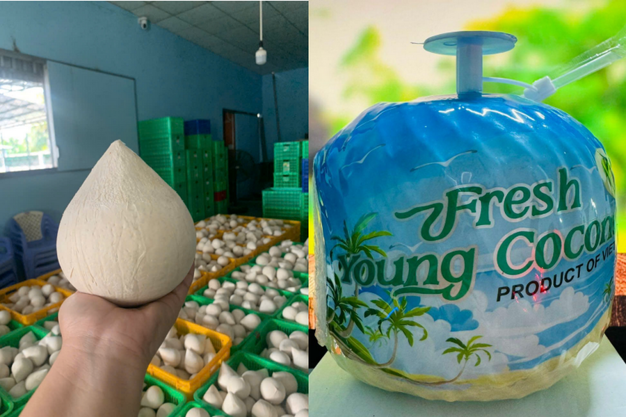Since Vietnam gained approval to export fresh coconuts to China in August, shipments have been gradually making their way to the Chinese market, starting in October. Tom Nguyen, of Viet Nam International Agriculture Co., Ltd., a prominent Vietnamese coconut exporter based in Bến Tre Province, shared insights on recent market feedback and the company's plans.
"Many Chinese companies have visited Vietnam to tour coconut orchards and factories, while various exporters have begun shipping fresh coconuts to China," Tom explained. "However, the current arrival volume remains limited as we focus on familiarizing ourselves with the export process, conducting sampling, and gauging market reactions."

Tom also highlighted the challenges faced during this initial phase. "The high cost of shipping has reduced the competitiveness of our coconut prices. Additionally, Vietnamese coconuts are smaller than Thai coconuts, leading buyers to expect lower prices. On the production side, many coconut growers hoped for strong prices and sales similar to durian, but the current market realities have not met those expectations."
Despite these challenges, Tom is optimistic. "Identifying these issues is an important first step. The coconut industry holds great promise for Vietnam's agricultural sustainability, and local authorities are actively seeking solutions. We are exploring alternatives to sea freight, such as rail shipments to Nanning or land transport across the border, while also working on ways to lower logistics costs to improve export competitiveness."

Looking ahead, Tom noted that the volume of Vietnamese coconuts arriving in the Chinese market is expected to increase significantly next month, with potential reductions in transportation costs. "We also need time for growers to align their expectations with market realities," he added.
Regarding product characteristics, Tom detailed the two main varieties of Vietnamese coconuts: Hybrid and Siem. Hybrid coconuts are larger, with a sweetness level of 5-8%, and are priced more competitively. Siem coconuts, on the other hand, are smaller, sweeter (7-9% Brix), and have a stronger aroma but come at a higher price. "Currently, most Chinese buyers prefer Hybrid coconuts as an entry point into the market. Once consumers become familiar with Vietnamese coconuts, they may consider the Siem variety," Tom explained.

The Vietnam Coconut Association has been proactive in supporting exports, including participation in trade exhibitions and facilitating industry connections. "According to the association, a significant increase in Vietnamese coconut arrivals is expected after November 16. These shipments will be distributed to wholesale markets and supermarkets," Tom said.

Outlining the company's strategy, Tom shared plans to prioritize B2B cooperation, particularly with wholesale markets. "We recently launched a new Vietnamese coconut brand called 'Cocotom.' We've received a lot of inquiries, and our first shipments under this brand are scheduled for November 23. Our goal is to build trust, expand steadily, and establish a strong brand presence," he explained.
Tom emphasized that their coconuts, sourced year-round from Bến Tre Province, maintain consistently high quality. "This season's coconuts are as stable and reliable as ever."










